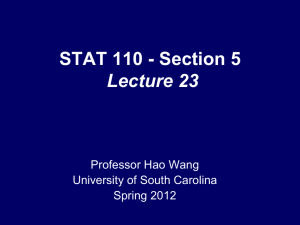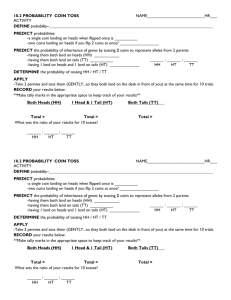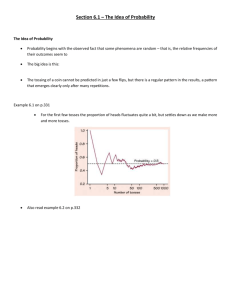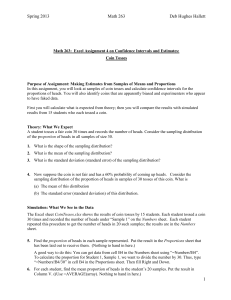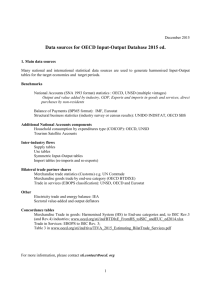Word - people.stat.sfu.ca
advertisement
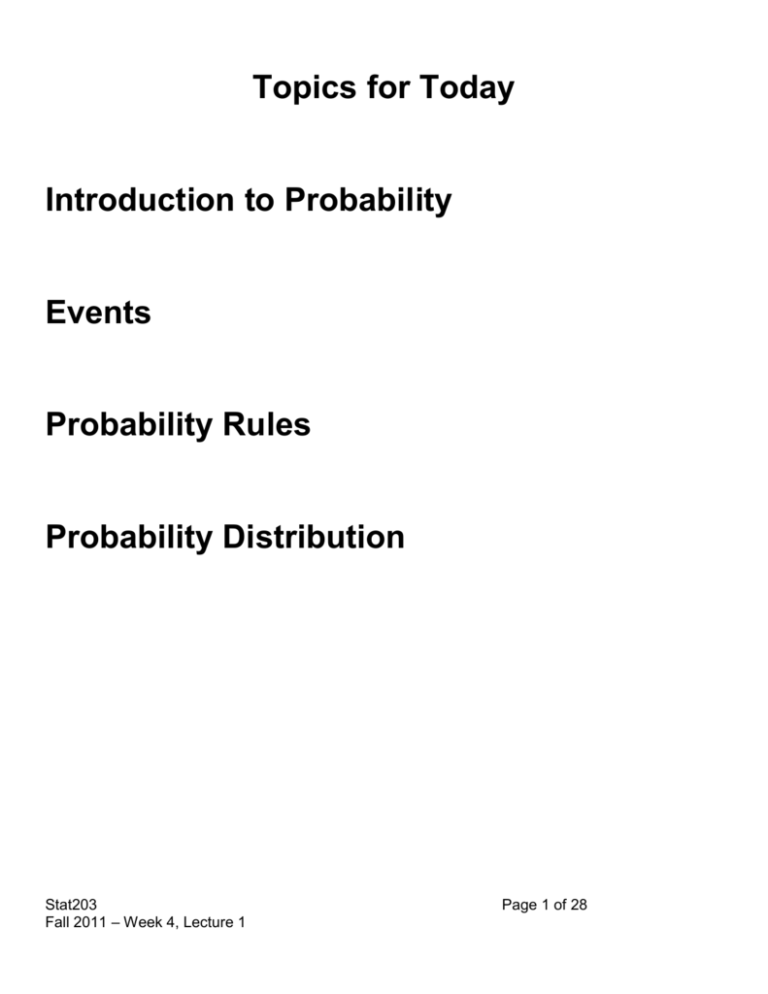
Topics for Today Introduction to Probability Events Probability Rules Probability Distribution Stat203 Fall 2011 – Week 4, Lecture 1 Page 1 of 28 Unlucky, Smartie-loving Dave 2 years ago Dave bought a laptop. Within the first 12 months, (by warranty) he had replaced: buetooth (x2), motherboard, heat sink, fans, ‘windows media button bar’ (x2), hard drive (x3) and company loyalty A colleague who bought the same computer had no such issues. Stat203 Fall 2011 – Week 4, Lecture 1 Page 2 of 28 When a company doesn’t do what it says, it’s expensive. To limit risks a company needs to know the _______ of a product failure or not being the advertised weight. The computer company needs to know the chances (probability) that a laptop will ____ in the first 1, 2 or 3 years. Because … On a laptop • Dell offers 1 year ‘free’ basic warranty. • Upgrade the basic warranty to 3 years is an extra $50 • Upgrade the basic warranty from 3 to 4 years is an extra $260 Dell believes that the chances of costly repairs increases with time and charge accordingly Stat203 Fall 2011 – Week 4, Lecture 1 Page 3 of 28 What does this have to do with Probability? ______ = Probability Probability is the __________ of an event given all possible events Probability = the number of times an event can occur ÷ The total number of times that any event can occur. Probability Rule #1: Probability is a number between _ (if it never ever happens) and _ (if it always happens) Stat203 Fall 2011 – Week 4, Lecture 1 Page 4 of 28 What’s an Event? Possible events: • ______________ OR computer doesn’t fail For computer failure: the ___________ of a computer failure = The number of computers that fail ÷ The total number of computers made Stat203 Fall 2011 – Week 4, Lecture 1 Page 5 of 28 Possible events: • _____________ OR don’t win lotto 649 the probability of a winning the lottery = The number of winning numbers ÷ The total number of possible numbers. There is only 1 (one) winning set of 6 numbers. There are 13,983,816 possible sets of 6 numbers that could come up. (49 x 48 x 47 x 46 x 45 x 44 ) ÷ (6 x 5 x 4 x 3 x 2 x 1) = 13,983,816 What’s the probability of winning? 1 ÷ 13,983,816 = Stat203 Fall 2011 – Week 4, Lecture 1 Page 6 of 28 [ Aside on Notation: P(A) is shorthand for the words “the probability of the event A occurring” From the prior examples we could write: P(computer fails) = the probability a computer fails P(win 649) = the probability of winning lotto 649) ] Stat203 Fall 2011 – Week 4, Lecture 1 Page 7 of 28 What about not winning Lotto 649? P(Not win) = Nnot win ÷ Ntotal There are 13,983,815 non-jackpot numbers among the 13,983,816 _____________ of 6 numbers that could come up. So, P(not win) = 13,983,815 ÷ 13,983,816 =0.99999992 In other words P(win) = 1- P(not win) or P(win) = 1-P( winc ) winc is the _________of the event [Another aside on notation … putting bars above words (as on page 139 of the text) is hard, so the superscript c will be used the same way] Stat203 Fall 2011 – Week 4, Lecture 1 Page 8 of 28 Probability Rule #2: the probability of an event’s converse is 1 minus the probability of the event. What are converses? Event Win the lottery Found Guilty Randomly selected person is a woman Stat203 Fall 2011 – Week 4, Lecture 1 Converse Don’t win the lottery Not Found Guilty Randomly selected person is not a woman Page 9 of 28 Example: Selecting a person in the MTF study In the MTF study, there are 6417 males and 6998 females. If we ________ choose one row from the MTF data set, the probability of it belonging to a a females is P(F) = Nfemale ÷ (Nfemale + Nmale) P(F) = ____ ÷ (____+6417) = 6,998 / 13,415 = ____ … or 52% Stat203 Fall 2011 – Week 4, Lecture 1 Page 10 of 28 More Rules for Probability Probability Rule #3: The additive rule means that if you have 2 mutually exclusive events, then the probability of one __ the other occurring is the ___ of the probabilities of either one. In terms of rolling a dice, this means: Define Events: E1 = Dice shows 1 E2 = Dice is Even What does P(E1 or E2) mean? P(E1 or E2) = P(E1) + P(E2) = (1/6) + (3/6) = 4/6 Mutually exclusive = both events cannot occur Stat203 Fall 2011 – Week 4, Lecture 1 Page 11 of 28 Probability Rule #4: the multiplication rule says that for two independent events, the probability of one event ___ another is the _______ of their probabilities In terms of flipping two coins: Define Events: H1 = heads on first coin H2 = heads on second coin P(H1 and H2) = P(H1) x P(H2) = (1/2)(1/2) =¼ Independent events are such that one event doesn’t influence the probability of the other Events for 2 coins = independent Events for 2 friends = not independent Stat203 Fall 2011 – Week 4, Lecture 1 Page 12 of 28 Example: Cancer Treatment New hope for kids with leukemia as new drug boosts survival rates New drug sends survival rate soaring from 30% to 87%, B.C.led study says BY PAMELA FAYERMAN, VANCOUVER SUN http://www.vancouversun.com/health/hope+kids+with+leukemia+drug+boosts+survival+rates/2094516/story.html Type of cancer: Philadelphia chromosome-positive acute lymphoblastic leukemia (Ph+ALL) Only about six children and 90 adults get it each year in Canada. The Phase 2 trial was conducted at 20 cancer centres, mostly in the U.S. (only two in Canada, Halifax and Vancouver). Stat203 Fall 2011 – Week 4, Lecture 1 Page 13 of 28 N = 157 patients “aged one to 21 years, enrolled in the trial from 2002 to 2006. They were divided into comparison groups and those who got the imatinib for the longest duration (280 continuous days, plus their intensive chemotherapy regimen), had the best outcomes.” Individuals? Method of Capturing data? Variables? Stat203 Fall 2011 – Week 4, Lecture 1 Page 14 of 28 Let’s define some events: • SnD = survive beyond 3 years no drug • SwD = survive beyond 3 years with drug What’s the converse for each of these events? From the paper, they found • P(SnD) = .30 • P(SwD) = .87 Stat203 Fall 2011 – Week 4, Lecture 1 Page 15 of 28 If two people have this type of Cancer and are taking the drug what is the probability that both survive for three years? Are these two events independent? Why: So, P(SwD and SwD) = P(SwD)*P(SwD) = .87 * .87 = .76 What about the overall result? Can we really say that P(SwD) > P(SnD) based on N = 157? If we look at a bigger sample we might have a better idea. Stat203 Fall 2011 – Week 4, Lecture 1 Page 16 of 28 The Probability Distribution The probability distribution is very similar to the __________________ distribution or _______ frequency distribution. But: remember that the frequency distribution related to the _______________ frequencies in our dataset The Probability distribution relates to the ___________ probability of all possible observations in our dataset. Stat203 Fall 2011 – Week 4, Lecture 1 Page 17 of 28 Events As coin flips (again) Outcomes from tossing two coins: • HH, TH, HT, TT So: P(2H) = ¼ P(1H) = 2/4 P(0H) = 1/4 This is the ________________________ of the number of heads from 2 coin flips. (we know coins [and dice and cards]pretty well so can figure out the probability distribution explicitly … you can’t do this for most events) Stat203 Fall 2011 – Week 4, Lecture 1 Page 18 of 28 The probability distribution tells us the ___________ of _________ any event Here is same the probability distribution of the number of heads in two coin tosses shown graphically: Stat203 Fall 2011 – Week 4, Lecture 1 Page 19 of 28 When we toss the two coins 4 times, and look at the _________ distribution, it probably won’t look like the ___________ distribution. Do 4 tosses of 2 coins and count the number of heads: Coin #1 Coin #2 Stat203 Fall 2011 – Week 4, Lecture 1 # Heads Page 20 of 28 From this sample, we can count the frequency of each possible number of heads: # heads Frequency Relative Frequency 0 1 2 Does this match the probability distribution we saw earlier? Stat203 Fall 2011 – Week 4, Lecture 1 Page 21 of 28 So making 4 tosses, is just like taking a ______ of 4 from a larger population of tosses … there is ___________ from sample to sample. Just like the Smarties example earlier. Stat203 Fall 2011 – Week 4, Lecture 1 Page 22 of 28 Key to Probability Distribution Probability distribution = ___________ Frequency distribution = _________ (observed from data) We need a lot of data to try to figure out what the theoretical probabilities are. Stat203 Fall 2011 – Week 4, Lecture 1 Page 23 of 28 Example: The Bent Quarter What’s the probability distribution of Heads for a bent quarter? Let’s start off by doing the frequency and relative frequency for 10 tosses: Stat203 Fall 2011 – Week 4, Lecture 1 Page 24 of 28 H? Total # heads So the relative frequency for Heads from the bent coin is: What’s our best guess at the probability distribution for the H event? Stat203 Fall 2011 – Week 4, Lecture 1 Page 25 of 28 A probability distribution is: a) A Theoretical thing that we get from the sample b) The underlying pattern to the histogram (the real curved line) d) The probabilities of events from the population Stat203 Fall 2011 – Week 4, Lecture 1 Page 26 of 28 Today’s Topics Introduction to Probability - Chance Rules - Rule 1: always between 0 and 1 - Rule 2: converse - Rule 3: addition - Rule 4: multiplication Probability Distribution - Theoretical version of the relative frequency distribution - Is approximated by the relative frequency distribution - Don’t always know it - Is represented by a histogram Stat203 Fall 2011 – Week 4, Lecture 1 Page 27 of 28 Reading for next lecture Chapter 5 – The Normal Curve Stat203 Fall 2011 – Week 4, Lecture 1 Page 28 of 28




